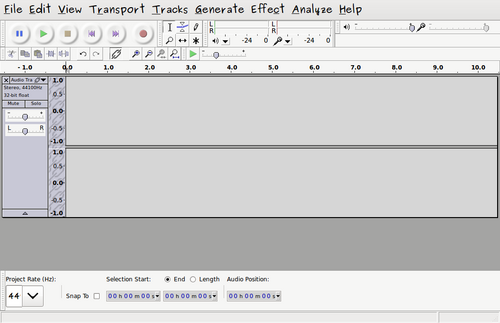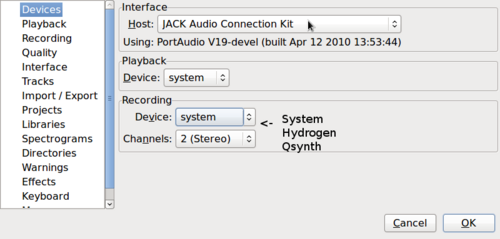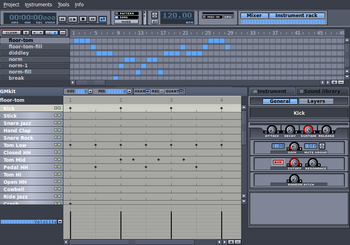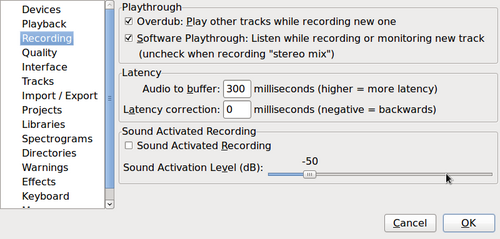Advanced Recording with Audacity
Contents
Prior Assumptions
For this tutorial, I am using the following Hardware to connect to Ubuntu Studio:
- Connected a Tascam US-122 Audio/MIDI USB device (confirmed that green light is "on").
Simplifying the Process
To be completed...
Using Audacity (Multi-track Recording)
Audacity is a simple to use and intuitive application to allow a user to record and manipulate an audio product. Audacity can record drumming tracks from Hydrogen, record keyboards from Qsynth, as well as record vocals from a microphone...
Steps to Launch Audacity
- In the Audacity menu bar, select EDIT -> Preferences
- The Audacity Preferences Dialog Box will appear.
- Remain in the default Devices tab.
- Under Interface section, the Host Should read Jack. If not, click the drop down box to select Jack
NOTE: If Ubuntu Studio was installed (i.e. Ubuntu Studio distribution CD, not just adding Ubuntu Studio to already installed system), Audacity should set the Jack Audio Server as the default interface.
If not, you can select the default interface manually:
Steps to Manually set Interface:
- In the Audacity menu-bar, select EDIT -> Preferences
- The Audacity Preferences dialog box application will appear.
- Remain in the default Devices tab.
- In the Interface Section, select Jack to be the host.
- Click OK to save changes.
The procedure to select different instruments in Audacity is subtle! I don't know if this is the BEST method, but here is what I know works...
Assuming that you are still in the Audacity Preferences dialog box (Devices tab), in the Recording section, click on the drop down menu for Devices. If you are running your Jack Audio server, and running Qsynth as well as Hydrogen, you should see 3 devices:
- Hydrogen (Drum Machine)
- Qsynth (Keyboards)
- System (Vocals via Microphone)
Let's add in each of these elements, track-by-track
Using Hydrogen (Drum Machine)
In the Audacity Preferences dialog box, under devices, select Hydrogen (Drum Machine), and close the dialog box. NOTE: Each time you want to "lay-down" a track using a different device, you MUST go to Audacity Preference dialog box and select your Recording Device...
Hydrogen is a drum machine application. It is useful to allow the user to record drumming patterns (to be looped), or entire drumming patterns for a song.
Although I prefer a REAL drummer, you can use a drum machine as a basis for your song. After the song has been recorded (via Audacity), you can mute the drumming pattern and replace with real drums...
The Hydrogen drum machine is pretty easy to use. Just press RECORD, and then click on an appropriate drum sound. The drumming pattern loops, so you can take your time to build more complex drumming patterns. Various drumming patterns can be saved and then can be added in a sequence to build a song... This application also has a "pattern" mode and a "song" mode...
Create a drumming pattern, and press play on the hydrogen application to test out the drumming pattern. Stop the drumming pattern.
When you are ready to record, click the record button in the Audacity transport toolbar, and then click the play button in the hydrogen application. Don't worry if there is blank audio, since you can always cut the unwanted portions of the track after recording. When finished, then click the stop button in Hydrogen, and then click the stop button in Audacity. It is recommended to immediately click the rewind button to set the position to the beginning of the track.
Dealing With Latency Issues (Keyboard)
When laying down multiple tracks among different instruments, you may find that a track may be out-of-sync with the other tracks. This is probably due to the latency or "delay" from playing your keyboard instrument.
Note that your keyboard is hooked up to a device to read input to the computer system. There will be latency (or in other words, a delay) between the time you press a key on the keyboard, and when that sound is generated via Qysnth. This is quite normal with other programs. In fact, when using my computer setup when playing keyboards, I have become so accustomed to the delay, that is takes me a second to realize it is not strange when playing a REAL piano with no latency!
The good news is that Audacity can be set to factor in the latency from devices such as keyboards. In fact, if you notice carefully after recording a keyboard track, that the length of the track (after recording is complete) will slightly compress to compensate for this latency or delay. Therefore, all that is required is to find the optimum "correction amount" to compensate for keyboard latency.
Steps to Compensate for Keyboard Latency:
- In the Audacity menu bar, select EDIT -> Preferences
- The Audacity Preferences Dialog Box will appear.
- Select the Recording tab.
- Increase or decrease the Latency Correction amount (in milliseconds) to obtain the correct balance.
- Click OK to save changes.
Mixing Down to OGG / MP3 File
To be completed...
Interesting Features
Importing Music into Audacity
To be completed ...
Reducing Tempo (Without Affecting Pitch)
To be completed ...
Creating Playback Loops
To be completed ...
Additional Resources
Tutorials
To be completed ...



